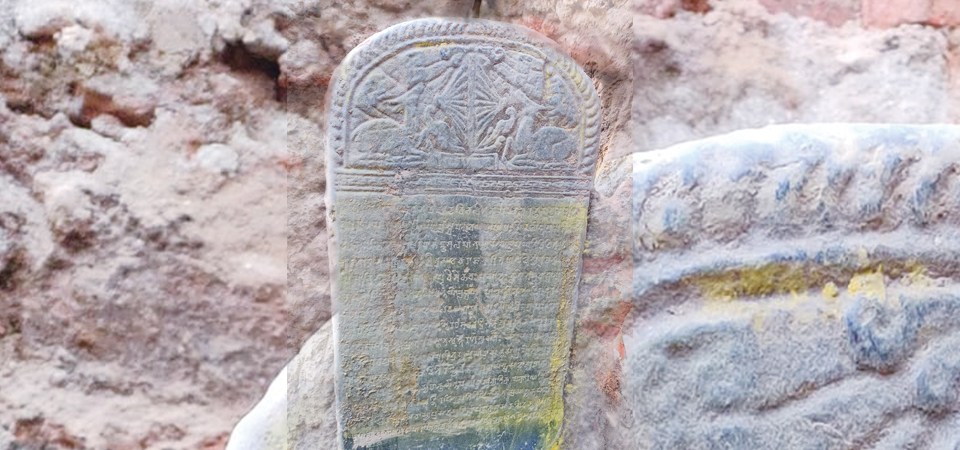History unearthed in Patan, literally

By Aashish Mishra
Lalitpur, Dec. 24: Around 35 years ago, while building a sewage system for the houses of Mangalbazaar, labourers unearthed a stone inscription in front of the Bhimsen Temple in Patan Durbar Square. This should have made big news and drawn the attention of historians and archaeologists but, for inexplicable reasons, it did not.
Work on the sewage continued and the inscription was covered with mud and concrete without anyone batting an eye, recalled Madhu Kumar Gyawali.
Gyawali, 54, was a student pursuing an intermediate degree in science (I. Sc.) back then and lived in a rented room with his brother in Tangal, a 10-minute walk from Mangalbazaar. “If only we had smartphones and cameras back then, it would have gone viral. Alas, we did not and they managed to keep it under wraps,” he said.
Cut to three and a half decades later and the tablet was rediscovered, once again while building a sewer, on Monday. This time though, as the work was being done under the supervision of the Department of Archaeology and the locals, it got the attention it deserved.
“The inscription, which is six-foot in length, was found intact behind a Hume pipe. At the top of the inscription are two deer facing a Dharma Chakra which shows that it is a Buddhist engraving,” archaeologist Prakash Darnal told The Rising Nepal. Darnal, who is the former chief of the National Archives, is also a member of the team presently overseeing the excavation work in the Durbar complex.
Epigraphist Shyam Sunder Rajbanshi is studying the carved text and he noted that it pointed to the presence of a monastery in the area. “The inscription talks about a Vihara built by Lichhavi king Brish Dev,” he informed. Brish Dev is the great grandfather of Mandev.
Several local folklores talk about a river flowing through what is today Patan Durbar Square. This river was a place of pilgrimage (Tirtha) and hence, the place was called Mani Tirtha. It later dried up but the place remained religiously significant, which is why Brish Dev built a monastery here. This monastery was later moved to a different location in the Malla era to make space for the palace and palace-adjacent structures we see today.
“To this day, a statue of Buddha is kept in a water-filled tank in front of the golden gate of the Patan Museum and worshipped throughout the Nepali month of Shrawan,” Rajbanshi said. “This also indicates that there was once a monastery here.”
The inscription, which contains 15 lines of text, also mentions the date Lichhavi Sambat 536 Jyestha Mase Shukla Paksha, which, as Rajbanshi explained, dates the inscription to around 613 AD.
In 1989, another inscription dated 536 was found in Gokarna’s Baluwa Gaun. That tablet talked about a state monastery (Rajvihara) established by Amshuverma. Patan’s inscription too mentions Amshuverma’s name along with his title Mahasamanta. This also includes the name of one Kumaramatya Chandrajeev. “The tradition of the time was to keep certain trusted people as witnesses while writing inscriptions. Chandrajeev may have been such a witness for this inscription as he is accredited as the ‘Dutak,’ comparable to a contact person of an organisation today.”
The inscription is written in Sanskrit using the Lichhavi script.
Rajbanshi has only managed to translate a small portion of the inscription though. “Many words and phrases are covered by cement which was used when constructing the sewage all those years ago. That needs to be cleared.”
He added, “Inscriptions are an important record of history. They need to be carefully and accurately translated and documented. We should not rush.” Meanwhile, as Rajbanshi’s study continues, the inscription has been taken to the nearby Patan Museum for safekeeping.
This is the second inscription found from under the ground in Patan Durbar Square this year. The first was one from the early medieval period which was found on September 14. It too was found while digging to build the sewage system.
The Lalitpur Metropolitan City has been implementing a sewage construction project in the city with the support of the Asian Development Bank.
Recent News

Do not make expressions casting dout on election: EC
14 Apr, 2022
CM Bhatta says may New Year 2079 BS inspire positive thinking
14 Apr, 2022
Three new cases, 44 recoveries in 24 hours
14 Apr, 2022
689 climbers of 84 teams so far acquire permits for climbing various peaks this spring season
14 Apr, 2022
How the rising cost of living crisis is impacting Nepal
14 Apr, 2022
US military confirms an interstellar meteor collided with Earth
14 Apr, 2022
Valneva Covid vaccine approved for use in UK
14 Apr, 2022
Chair Prachanda highlights need of unity among Maoist, Communist forces
14 Apr, 2022
Ranbir Kapoor and Alia Bhatt: Bollywood toasts star couple on wedding
14 Apr, 2022
President Bhandari confers decorations (Photo Feature)
14 Apr, 2022









